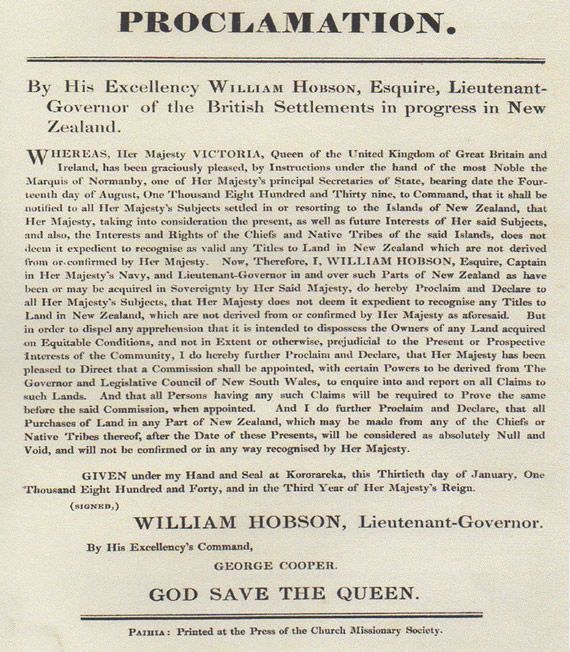Because of Ngapuhi’s Atrocities, New Zealand Became a British Colony!
While Ngapuhi are stating they did not give up their sovereignty in 1840, they initiated Britain becoming involve in New Zealand when their 13 chiefs wrote to King George IV asking him to be their guardian and protector. When James Busby offered tangata maori sovereignty over all the islands of New Zealand in 1835 he could only attract 52 chiefs to sign the Declaration of Independence with over 500 agreeing to British Sovereignty by the Treaty of Waitangi in 1840. While the Treaty of Waitangi confirmed British sovereignty over all the islands of New Zealand on the 21 May 1840, it was of little interest to Britain with no mention of the Treaty of Waitangi in the Royal Charters/Letters Patents of 1839 and 1840 or Lt. Governor Hobson’s two Proclamations read at Waitangi on the 30 January 1840. Our true Founding Documents and first Constitution.
Why have governments and our academics overlooked these vital documents that made New Zealand into a British Colony under one flag and one law on the 3 May 1840 and have now hidden them amongst the 6 million other documents at Archives New Zealand?
There were many wars between the tangata whenua, the original inhabitants of New Zealand and the tangata maori tribes who arrived in the 14th century and after the tangata whenua were driven into the hills and disappeared, the tangata maori tribes continued to fight for territories but no more so than when Hongi Hika returned from England after helping Dr Samuel Lees with his Maori to English dictionary. Hongi Hika had an ulterior motive when travelling to England in 1819 with his friend Waikato and that was to purchase as many muskets as possible. While he was in England he informing King George IV he was, “The King of New Zealand” or hoped to be after he returned to New Zealand with hundreds of muskets. See, “The Musket Wars” by R D Crosby.
While Hongi Hika was not allowed to purchase muskets while in England he did a secret deal with Frenchman, Baron Charles de Thierry by trading 40,000 acres of land in Northland for 500 muskets. He then had de Thierry ship these muskets to Australia under de Thierry’s name to be pick up later on his way back to New Zealand in 1820.
Mainly on the instructions of his blind wife, Hongi Hika and his Ngapuhi followers went on a very cowardly rampage south slaughtering thousands of unarmed men, women and children just for the fun of it and the feasts that followed. Only moving on to the next village to repeat this cowardly act when the stench of rotting bodies became unbearable. While Hongi Hika was doing this in the North Island, Te Rauparaha was doing the same in the South Island where many of the South Island chiefs that had been defeated travelled to New South Wales to sell their defeated lands. Virtually the whole of the South Island and large areas of the North Island, about 2/3 of New Zealand had been sold before the Treaty of Waitangi was signed on the 6 February 1840. At the time the Treaty was signed, tangata maori only “occupied” about 1/3 of New Zealand although most of this land was returned to tangata maori by the government after the Treaty had been signed without compensation to the purchasers.
By 1831 the Southern tribes were arming themselves for utu/revenge against Hongi Hika’s cowardly attacks before they had muskets. With Ngapuhi fearing these attacks, 13 Ngapuhi chiefs wrote to King William asking him to be their guardian and protector. See letter below.
Britain responded by sending James Busby as Resident to bring peace between the tribes and protect the people of England and their investments that were beginning to settle in New Zealand. He also organised New Zealand first flag for New Zealand ships to sail under. Twenty five chiefs voted with 12 agreeing to a flag on the 20 March 1834, which had already been used by the Church Mission Society. See: https://nzhistory.govt.nz/culture/taming-the-frontier/first-flag
James Busby also drafted the Declaration of Independence in 1835 but was a complete failure as he could only attract 52 chiefs to sign it after three years of trying. The Declaration was to recognised tangata maori sovereignty over New Zealand and for the chiefs that signed it to meet annually to make laws, bring peace and to encourage trade, but the chiefs were more interested in continuing their fighting, as always and it was abandoned without one meeting taking place. Fifty two chiefs could hardly speak for the 100,000 tangata maori living in New Zealand at the time. The Declaration of Independence was a complete failure!
As tangata maori were not interested in forming their own government, Britain had to take a more active role in bringing peace between the tribes that were rapidly declining in numbers and to protect her people and their investments in New Zealand. After 3 years of debate, Britain reluctantly extended the boundaries of New South Wales to include all the island of New Zealand on the 15 June 1840 by the 1839 Charter/Letters Patent. Lt. Governor Hobson reading the two Proclamations in New Zealand on the 30 January 1840. While no mention of a Treaty was mentioned in any of these documents it did state, “Which is or maybe acquired in Sovereignty by Us Our Heirs or Successors within that group of Islands in the Pacific Ocean commonly called New Zealand”. This could also have been achieved by the Law of Nations (1).
Governor George Gipps had told Hobson, tangata maori had sold large areas of New Zealand to people from other lands with many of the Deeds of Sale still held in the New South Wales Supreme Court. It is estimated over 2/3 of New Zealand had been sold by the tangata maori chiefs before the Treaty of Waitangi was signed on the 6 February 1840. This is the reason for “all the people of New Zealand” being represented in Article 2 of the Treaty of Waitangi.
Britain could have taken control of New Zealand by the Law of Nations (1) as she had most other countries but the Clapham Sect (2), a very strong group of people had forced the British Parliament to ask tangata maori consent to give up the territories they still “occupied” by treaty. The instructions for the treaty being drafted by Sir James Stephens, the Undersecretary for the Colonies and a very strong supporter of the Clapham Sect (2).
If tangata maori wanted protection and “The same rights as the people of England” as British Subjects, then they must sign the Treaty of Waitangi and place their territories they still “occupied” under British Sovereignty. Over 500 chiefs signed the Treaty of Waitangi on behalf of their people and Britian declared sovereignty over New Zealand on the 21 May 1840.
The Charter/Letters Patent of 1839 was a temporary measure until Britain found out how many chiefs would agree to give up the territories they “occupied”. Over 500 chiefs agreed on behalf of their tribes to give up their territories in favour of British sovereignty and became British Subjects, “With the same rights as the people of England”. Article 2, Treaty of Waitangi.
The Treaty of Waitangi was an agreement between Queen Victoria and tangata maori with instructions drafted by Sir James Stephens, Undersecretary for the Colony’s and a strong supporter of the Clapham Sect (2) in 1838 and before Britain had decided if or how to become further involved in New Zealand. It was decided tangata maori that gave up their territories to the Queen by treaty, would become British Subjects, “With the same rights as the people of England”. It is interesting to note that the notice that Britain had gained sovereignty over all the island of New Zealand was published in the London Gazette on the 2 October 1840 and one month later produced the beautifully prepared, written and presented Royal Charter/Letters Patent dated the 16 November 1840, our true Founding Document and first Constitution. This document must have been “sitting in the wings” until Britain received notification the Treaty was successful. It could not have gone through the British Parliament, been legally discussed and written within one month. See Royal Charter page 7.
Once Britain found out that the majority of chiefs had given up the territories they still “occupied” to Britain, Britain separated New Zealand from New South Wales by Royal Charter/Letters Patent dated the 16 November 1840 with New Zealand becoming an independent British Colony with its own Governor and Constitution to make laws with courts and judges to enforce those law, under one flag and one law, irrespective of race colour or creed. See: http://www.austlii.edu.au/au/journals/AUJlLawSoc/1985/10.pdf
The National Government hides our true Constitutional Documents
On the 17 April 2017 the National Government hid our Constitutional documents in favour of the failed Declaration of Independence and the Treaty of Waitangi that had nothing to do with New Zealand coming under the laws and dependency of New South Wales on the 25 June 1839 or a British Colony on the 3 May 1841.
While previous Governments have ignored the Royal Charter/Letters Patents of 1839 and 1840, our true Founding Documents and first Constitution that made New Zealand into British Colony, the National Government dismantled the Constitution Room on the 17 April 2017 that held our Constitutional Documents and has placed them in New Zealand Archives Repository among the 6 million other documents where they will soon be forgotten and lost for ever. All this to appease the Maori Party at the expense of all the people of New Zealand. How corrupt is that!
The government has built the $7.2 million He Tohu exhibit at the National Library, Wellington with taxpayer’s money to house the Declaration of Independence and the Treaty of Waitangi which they call, “Our iconic Constitutional Documents”. This is a deliberate lie to elevate the Declaration of Independence and Treaty of Waitangi to something they were never intended to be. New Zealand was founded on four Constitutional Documents,
- The Royal Charter/Letters Patent of 1839.
- Governor Hobson’s two Proclamations on the 30 January 1840.
- The Royal Charter of 1840.
Now that you know how New Zealand became a British Colony under one flag and one law that governments and our academics have continued to hide from you, it’s time to put pressure on the National Government to stop this corruption and display our true Founding Documents and first Constitution at the He Tohu exhibit at the National Library Wellington.
If the National Government will not agree to this, then we have no other option than to vote for a Political Party that will, therefore this question must be asked at the lead up to the upcoming elections, “Will you support placing our Constitutional Documents in the He Tohu exhibit at the National Library, Wellington and at Te Papa our National Museum?”
Below is documented evidence to support this article.
- The Law of Nations recognized no other mode of assuming dominion/sovereignty in a country of which the inhabitants were ignorant of the meaning of sovereignty, and therefore incapable of ceding sovereignty rights. This was the case with the people inhabiting New Zealand, for whom it would have be impossible for Captain Cook or Lt. Governor Hobson to have obtained British sovereignty by cession. Tangata maori consisted of hundreds of small individual tribes without any form of united government continually at war with each other for territories.
- The Clapham Sect was a group of aristocratic evangelical Anglicans, prominent in England from about 1790 to 1845, who campaigned for the abolition of slavery, to protect indigenous peoples from colonial exploitation and to promote missionary work at home and abroad. The group centered on the church of John Venn, rector of Clapham in south London. While little, if anything is published about the Clapham Sect in New Zealand’s history, it had a great influence on the instructions given to Captain William Hobson on the drafting of the Treaty of Waitangi by Sir James Stephens, the Undersecretary for the Colonies and a very strong supporter and member of the Clapham Sect. Sir James Stephens had also drafted the “Slavery Abolition Act of 1833”.
Letter from 13 Ngapuhi chiefs asking King William for protection in 1831 New Zealand.
(Enclosure 2 in No.1.) From William Yate, Esq, Waimate, New Zealand, to the Colonial Secretary, New South Wales, November 16, 1831.
Sir, I have the honour to forward to you, by His Majesties Ship, “Zebra” the enclosed New Zealand document, with its translation, and to request that you will lay it before the Governor for his information. I have further to request that it be transmitted through His Excellency to the Secretary of State, in order to it being laid before His Majesty.
I have, &c,
(Signed) William Yate.
___________________________________________________________________________ (Enclosure 3 in NO.1)
To King William, The Gracious Chief of England.
King William
To King William, the gracious Chief of England. King William, we, the chiefs of New Zealand assembled at this place, called the Kerikeri, write to thee, for we hear that thou art the great chief of the other side of the water, since the many ships which come to our land are from thee. We are a people without possessions. We have nothing but timber, flax, pork and potatoes. We sell these things however to your people; then we see property of the Europeans. It is only thy land, which is liberal towards us. From thee also come the missionaries who teach us to believe on Jehovah God and on Jesus Christ His Son. We have heard that the tribe of Marian [the French] is at hand, coming to take away our land. Therefore we pray thee to become our friend and the guardian of these islands, lest the teasing of other tribes should come near us, and lest strangers should come and take away our land. And if any of thy people should be troublesome and vicious towards us we pray thee to be angry with them that they may be obedient, lest the anger of the people of this land fall upon them. This letter is from us, the chiefs of the natives of New Zealand.
(Signed) William Yate, Secretary to the Church Mission Society, New Zealand.
Wererahi Chief of Paroa.
Rewa Chief of Waimate
Patuone & Nene Two brothers, Chiefs of Hokianga
Kekeao Chief of Ahuahu
Titore Chief of Kororarika
Tamoranaga Chief of Taiamai
Ripe Chief of Mapere
Hara Chief of Ohaiawa
Atuahaere Chief of Kaikohe
Moetara Chief of Pakanai
Matangi Chief of Waima
Taunai Chief of Hutakuta
Below is the ‘Charter/Letters Patent’ appointing William Hobson as Lieutenant Governor of New Zealand and extending the boundaries of New South Wales to include all the islands of New Zealand in 1839. Sir George Gipps, Governor of New South Wales was in fact the first governor of New Zealand, but later delegated his powers to Lt Governor Hobson.
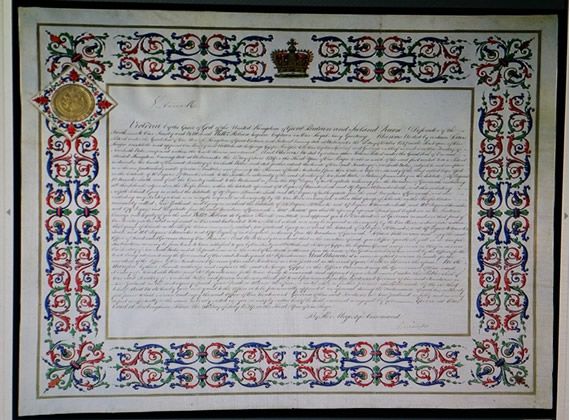
The document reads:
Victoria R
Victoria by the Grace of God of the United Kingdom of Great Britain and Ireland Queen, Defender of the Faith – To Our Trusty and Well beloved William Hobson Esquire, Captain of the Royal Navy Greeting. Whereas We did by certain Letters Patent under the Great Seal of Our United Kingdom of Great Britain and Ireland bearing date at Westminster the 5th day of October 1837 in the First year of Our Reign constitute and appoint Our Trusty and Well beloved Sir George Gipps, Knight, to be Our Captain General and Governor in Chief in and over Our Territory of New South Wales, comprised within the limits therein mentioned. And Whereas We did by certain other Letters Patent under the Great Seal of Our said United Kingdom, bearing date at Westminster the 15th day of June 1839 in the Third Year of Our Reign revoke so much of the said first recited Letters Patent as describes the limits of Our said Territory of New South Wales, and did further extend the limits of Our said Territory of New South Wales (subject to such exception as is therein particularly made of certain Territories now forming the Province of South Australia) from the Northern Cape or extremity of the Coast called Cape York in the latitude of 10 Degrees 37 Minutes South to the Southern extremity of the said Territory of New South Wales or Wilson’s promontory in the latitude of 39 Degrees 12 Minutes South and of all of the Country inland to the Westward as far as the 129th Degree of East longitude reckoning for the Meridian of Greenwich including all the Islands adjacent in the Pacific Ocean within the latitude aforesaid of 10 Degrees 37 Minutes South and 39 Degrees 12 Minutes South, and also including Norfolk Island lying in or about the latitude of 29 Degrees 3 Minutes South and 168 Degrees of East Longitude from the said Meridian of Greenwich, and also including any Territory which is or maybe acquired in Sovereignty by Us Our Heirs or Successors within that group of Islands in the Pacific Ocean commonly called New Zealand, and lying in or about the latitude of 34 Degrees Minutes and 47 Degrees 10 Minutes South, and 166 Degrees 5 Minutes and 179 Degrees East longitude from the said Meridian of Greenwich. Now Know you that We reposing especial Trust and Confidence in the Prudence Courage and Loyalty of you the said William Hobson do by these Present constitute and appoint you to be Our Lieutenant Governor in and over that part of Our Territory so described as foresaid in Our said last recited Letters Patent which is or maybe acquired in Sovereignty by Us Our Heirs or Successors within that group of Islands in the Pacific Ocean commonly called New Zealand, lying in or about the latitude of 34 Degrees Minutes and 47 Degrees 10 Minutes South, and 166 Degrees 5 Minutes and 179 Degrees East longitude reckoning from the Meridian of Greenwich. To have hold exercise and enjoy the said Office of Lieutenant Governor during Our Pleasure: And We do hereby command that in the execution of such your Office you do obey all such lawful Instructions as may be from time to time addressed to you by Our Trusty and Well beloved Sir George Gipps, Our Captain General and Governor in Chief in and over Our Territory of New South Wales and its Dependencies or in the event of his death or absence from the limits of his Government and command by the Officer for the time being administering the Government of Our said Territory and its Dependencies. And Whereas it is necessary that provision be made for the execution of the Office of Our Lieutenant Governor of Our said Territories in New Zealand in the event of your Death or absence therefrom, We do therefore by these Presents authorise and empower the said Sir George Gipps or the Officer Administering the Government of Our said Territory of New South Wales and its Dependencies for the time being to nominate and appoint by an Instrument under the Public Seal of Our said Territory of New South Wales, such person as he may think fit to act provisionally as Our Lieutenant Governor of Our said Territories in New Zealand in the contingency of such your Death or absence therefrom, or until other or further provision shall be made by Us in that behalf. And We do hereby give and grant to the Officer so to be provisionally appointed as aforesaid, during the continuance of such his authority full power to hold exercise and enjoy the said Office of Our Lieutenant Governor of Our said Territories in New Zealand as fully and in every respect as effectually as the same as is hereby vested in you, or may be by virtue hereof be held, exercised or enjoyed by you – Given at Our Court at Buckingham Palace the 30th day of July 1839, in the Third Year of Our Reign. By Her Majesty’s Command, Lord Normandy.
There is no mention in any of these 4 Constitutional documents of a Treaty between Queen Victoria and tangata maori. Britain had extended the boundaries of New South Wales on the 15 June 1839, “which is or maybe acquired in Sovereignty by Us Our Heirs or Successors within that group of Islands in the Pacific Ocean commonly called New Zealand”, while the Treaty had little, if any part in New Zealand becoming a British Colony on 3 May 1841.
Below is Queen Victoria’s Royal Charter/Letters Patent dated the 16 November 1840. The Constitution of the Colony of New Zealand into a separate colony on the 3 May 1841. Archives New Zealand Ref. No. ACGO 8341 1A1 9.
Royal Charter of 1840. Constitution of the Colony of New Zealand into a separate Colony 3 May 1841.
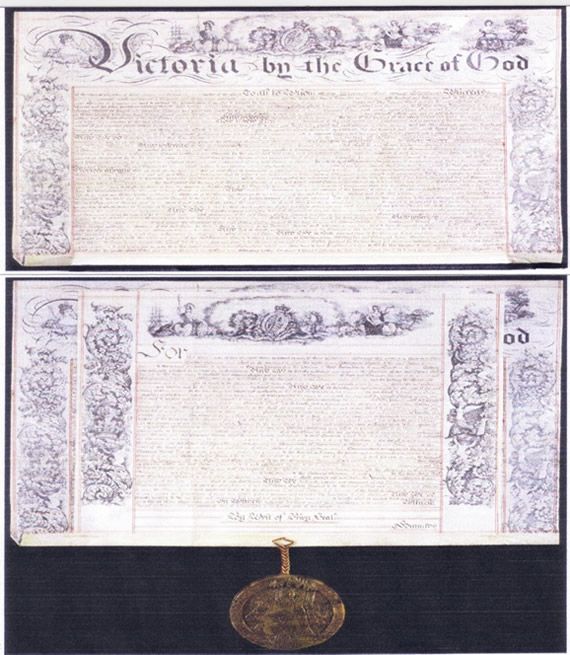
This is New Zealand true Founding Document and first Constitution.
The Constitution Reads:

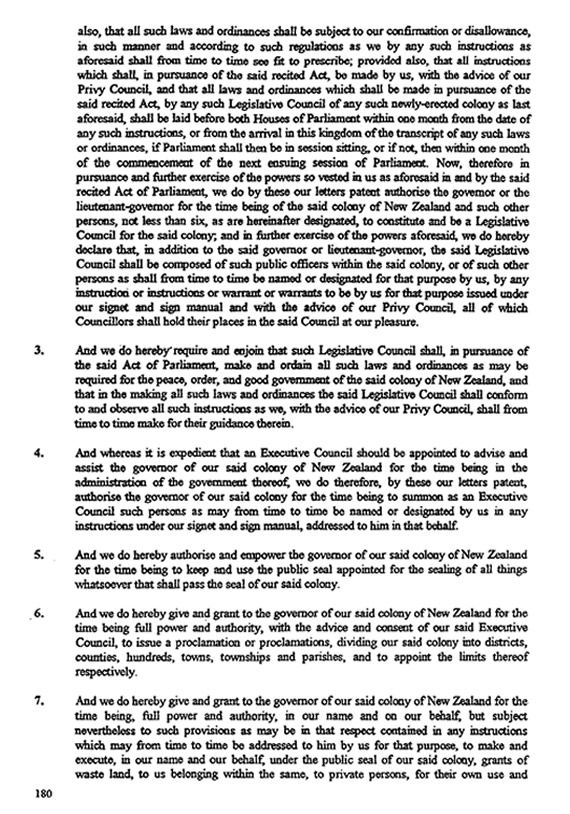
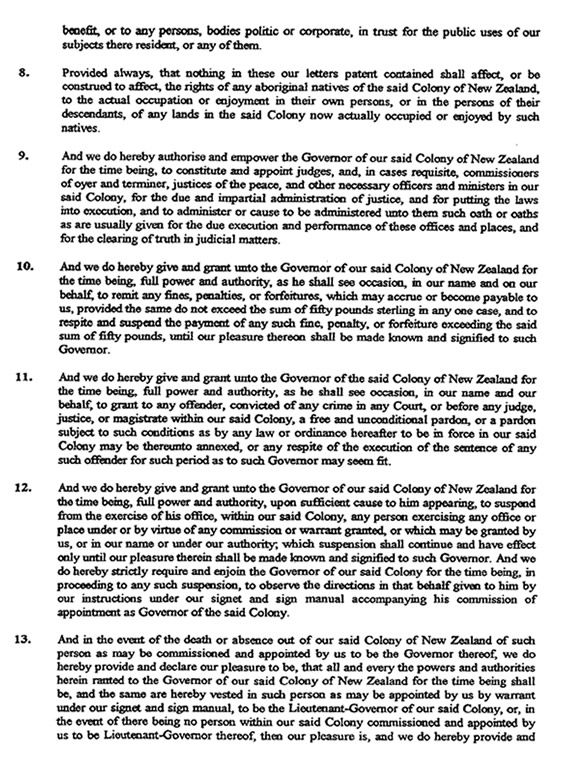
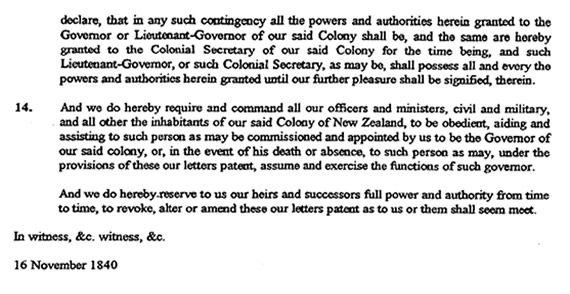
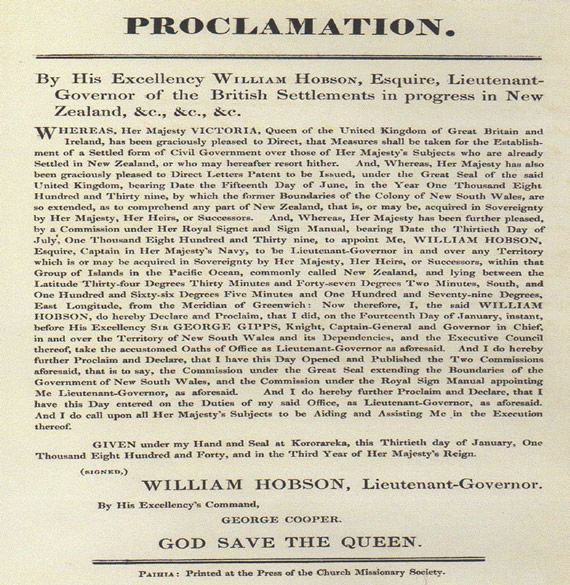
The Question that must be asked; “Why have our academics not researched and published this vital documentation that established the Colony of New Zealand”?
Have they been paid by Government to ignore it or have they been too lazy to do their own researched and just followed those before them? Whichever way, they have a lot of explaining to do, they have destroyed New Zealand society as intended by our ancestors both tangata maori and Pakeha when they signed the Tiriti o Waitangi in 1840 with a hand shake and the words,
“He iwi tahi tatou – We are now one people”.
Prepared by the One New Zealand Foundation Inc. 29 July 2017. Copyright.
For further information: www.onenzfoundation.co.nz or email: ONZF@bigpond.com.au.


